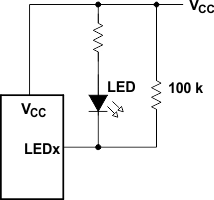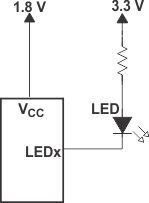ZHCSP01 July 2022 TCAL9539
ADVANCE INFORMATION
- 1 特性
- 2 应用
- 3 说明
- 4 Revision History
- 5 Pin Configuration and Functions
- 6 Specifications
- 7 Parameter Measurement Information
- 8 Detailed Description
- 9 Application and Implementation
- 10Device and Documentation Support
- 11Mechanical, Packaging, and Orderable Information
封装选项
机械数据 (封装 | 引脚)
散热焊盘机械数据 (封装 | 引脚)
- RTW|24
订购信息
9.2.2.1 Minimizing ICC When I/Os Control LEDs
When the I/Os are used to control LEDs, normally they are connected to V through a resistor as shown in Figure 9-2. For a P-port configured as an input, current consumption increases as VI becomes lower than V. The LED is a diode, with threshold voltage VT, and when a P-port is configured as an input the LED are off, but VI is a VT drop below VCC.
For battery-powered applications, it is essential that the voltage of P-ports controlling LEDs is greater than or equal to V when the P-ports are configured as input to minimize current consumption. Figure 9-2 shows a high-value resistor in parallel with the LED. Figure 9-3 shows V less than the LED supply voltage by at least VT. Both of these methods maintain the I/O VI at or above V and prevent additional supply current consumption when the P-port is configured as an input and the LED is off.
 Figure 9-2 High-Value Resistor in Parallel with LED
Figure 9-2 High-Value Resistor in Parallel with LED Figure 9-3 Device
Supplied by a Lower Voltage
Figure 9-3 Device
Supplied by a Lower Voltage